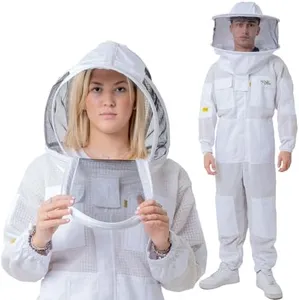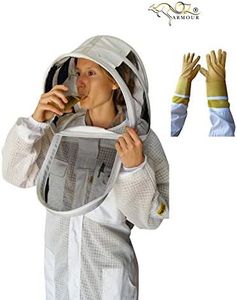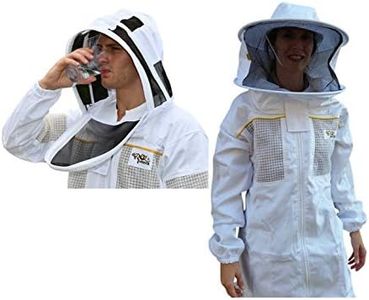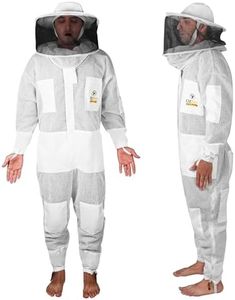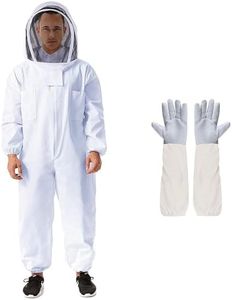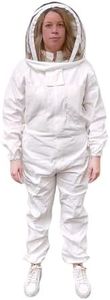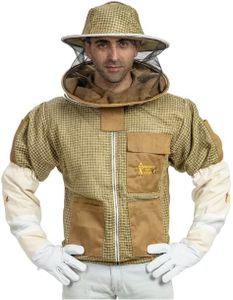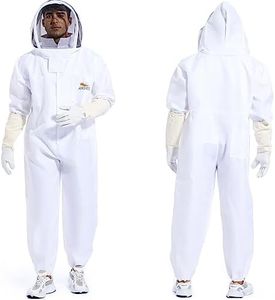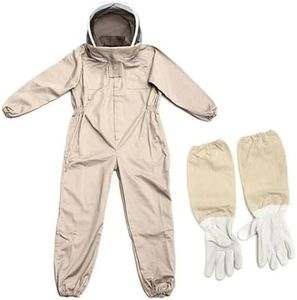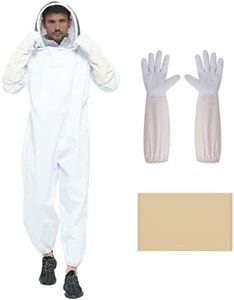We Use CookiesWe use cookies to enhance the security, performance,
functionality and for analytical and promotional activities. By continuing to browse this site you
are agreeing to our privacy policy
10 Best Bee Suits
From leading brands and best sellers available on the web.By clicking on a link to a third party's website, log data is shared with that third party.
Buying Guide for the Best Bee Suits
Choosing a bee suit is all about balancing protection, comfort, and ease of use. Whether you are a beginner beekeeper or someone with more experience, the right bee suit can make working with bees safer and more comfortable. Focus on key features that ensure you are protected from stings, able to move freely, and comfortable while working for extended periods. It's important to reflect on how often you will be using the suit, your local climate, and your personal preferences for visibility and dexterity.MaterialMaterial is the fabric from which the bee suit is made, and it's crucial because it determines both your level of protection and how hot or heavy the suit feels. Common materials include cotton, polyester, and ventilated mesh. Cotton is thick and offers good protection but can be hot; polyester is lighter and dries easily if washed; ventilated suits use layers of mesh to increase airflow, making them cooler but possibly a little heavier. If you live in a hot climate or get uncomfortable easily, a ventilated suit is preferable. If protection from stings is your top concern and you don’t mind a little heat, go for thick cotton.
Veil TypeThe veil is the netted hood that protects your head and face—arguably the most important part of the bee suit. There are several styles: round, fencing, and collapsible. A round veil keeps the netting away from your face, providing the best visibility and ventilation. Fencing veils fit closer to your head and are less bulky, which can be good in tight spaces but might be less airy. Collapsible veils are easy to fold and store. If you’re a beginner or will be outside in bright sun, a round veil offers comfort and visibility. For experienced users or if you need to work in cramped places, a fencing veil might suit you better.
Fit and SizeThe fit and size of your bee suit affect both your safety and how comfortable you feel. A loose fit is important because it prevents bees from getting close to your skin and stinging through the fabric. At the same time, the suit shouldn’t be so baggy that it trips you up or restricts your movements. Sizes are usually marked like regular clothing (S, M, L, etc.), but it’s a good idea to size up for extra room. Always think about wearing clothes underneath and consider the range of motion you’ll need. If you’ll be doing a lot of lifting or bending, a slightly looser fit is preferable.
Closure TypeClosure type refers to how the suit zips up and seals, which keeps bees out. The most common are zippers, but some suits may use Velcro or elastic at wrists and ankles. Zippers are fast and secure but should be high quality to prevent gaps. Additional Velcro or elastic at openings can offer backup protection. If you want a suit that’s easy to get in and out of, look for long, sturdy zippers and secure all closure points with extra flaps or elastic.
VentilationVentilation is the suit’s ability to allow airflow and keep you cool during use. This matters a lot if you work in warm climates or spend long hours with your bees. Ventilated suits use mesh panels or layers of breathable fabric, reducing overheating. If you tend to get hot or sweat easily, prioritizing ventilation will help keep you comfortable and focused.
Pockets and AccessibilityPockets and accessibility refer to storage for small tools and how easily you can reach parts of your suit or body while wearing gloves. Multiple well-placed pockets are helpful for carrying hive tools, pens, or your phone. If you like to work efficiently and keep your hands free, opt for a suit with roomy, easy-to-access pockets and zippers designed for use with gloves.
Elasticity and CuffsElasticity and cuffs are features around the wrists, ankles, and waist that keep the suit snug and prevent bees from entering at these points. Secure elastic bands or adjustable cuffs are essential for full protection. If you work around very active or aggressive bees, look for suits with strong, snug elastic and additional thumb or foot straps.
